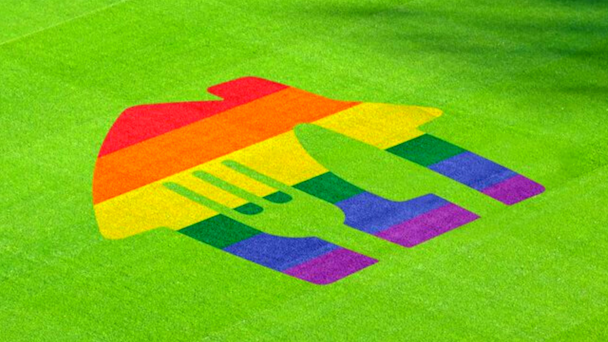Qatar 2022 World Cup offers brands opportunity to make a stand
Lee Mabey, DEI lead of media at Dentsu and managing partner of Dentsu X, has laid out how brands should make a stand ahead of the Qatar 2022 World Cup. There will likely be friction around workers and LGBTQ+ rights – so how can sponsors (and guerilla brands) make the most of the tournament?

Just Eat made a stand during Euro 2020
The draw for Qatar 2022 has left England fans dreaming that this is the year it will be coming home (and Scotland or Wales might yet have something to say about that). But it promises to be a tournament like no other – and not all for the right reasons.
The selection of Qatar as the host nation has been controversial from the outset. A much-derided selection process and playing in the oppressive Qatari summer heat were early contentious issues (although the move to a winter tournament has hardly been a popular decision).
Since then, the spotlight has been on the country’s human rights record. A 2021 report from The Guardian claimed that 6,500 migrant workers recruited for the extensive infrastructure project needed to deliver the tournament have died (the Qatari Supreme Committee for Delivery & Legacy state there have been 37 deaths among workers directly linked to the building of stadiums).
And Qatar has an appalling record on LGBTQ+ rights, with male homosexuality punishable by prison, a fine or possibly death. Former Fifa president Sepp Blatter said soon after announcing Qatar as hosts that gay football fans “should refrain from any sexual activities.” This is the same Fifa that want football to be “accessible and inclusive in all respects.”
-
Qatar World Cup sponsors must be ready to deal with ugly side of the beautiful game
-
TV Talks podcast: ITV on TV advertising during Christmas World Cup
-
5 things media buyers need to know about football fans ahead of World Cup 2022
It is against this backdrop that marketers need to consider the ethics of spending around the tournament. However, this is not new territory. There are myriad examples of global sporting events hosted by countries with poor human rights records.
Let’s make one thing clear. Despite the protestations, Qatar 2022 will be going ahead. Therefore, marketers need to acknowledge it or stay away.
Being held during November and December means the World Cup falls in the ‘Golden Quarter’ and will only amplify the peak winter TV schedule. Almost 24 million people watched England’s historic victory against Denmark in the Euro 2020 semi-finals, and a combined 29.85 million watched the final. Should England have similar success, we could expect similar viewing levels again. Will brands really want to miss out on those audiences? I do not think so.
Marketers will question the connotations of advertising in ad breaks during matches. Let’s make a clear delineation between investing in ad spots and investing in Qatar 2022. Ad revenue in TV goes to the broadcasters, not the host nation. Therefore, many will have a clear conscience investing in spots around Qatar 2022. Yet some marketers will still feel conflicted.
This could be the ideal opportunity to demonstrate that oft-mocked term – ‘brand purpose.’
Brands could use spots to demonstrate their corporate values, not push products. Channel 4 report only 3% of ads contain LGBTQ+ representation (and the vast majority focus on the G). Increasing LGBTQ+ representation in ads will make a statement of allyship far beyond Pride month in June. Of course, brands must avoid accusations of tokenism, which have long plagued queer representation in brand communications. Working with community groups or LGBTQ+ publishers will assist in delivering authentic representation.
There is also the opportunity to shine a light on human rights issues. I predict one brand will go all in and align with a major human rights organization during the tournament. This might include featuring QR codes directing audiences to donate to charities, or content series highlighting the systemic abuses facing migrant workers. This cannot be a short-term marketing tactic and must be handled with the utmost sensitivity. Brands cannot be seen to be profiteering from suffering.
We should also not forget the power of talent. The age of the anodyne footballer is coming to an end. Marcus Rashford has spoken candidly about growing up in food poverty, which seems to have empowered players to discuss issues outside of the game. England captain Harry Kane has addressed human rights abuses in the Gulf state, and Netherlands manager Louis van Gaal has been forthright in his opinions on Fifa’s decision to host the tournament in Qatar. Expect this to be an ongoing trend in the lead-up to and during the tournament as more people in the game feel emboldened to speak out on injustices. Players have found finally found their voice and could become a powerful tool in any marketer’s kit this year.
With the focus rightly on human rights and repressive LGBTQ+ policies, it is easy to overlook the significance of Qatar 2022 as the first World Cup in the men’s or women’s game to be hosted by a Muslim nation. This presents a significant opportunity for brands to increase their engagement with and representation of Muslim audiences. The tournament could be a launchpad to generating a better understanding of the UK’s 3 million Muslims, an audience often underrepresented by brands.
As we approach kick-off to Qatar 2022 marketers face a significant – but not insurmountable – challenge. Ignoring it (and the huge audience numbers it brings) could be an own goal. Brands have the golden opportunity to showcase purpose. Those who have the right message can turn a situation that initially feels unjust into something powerful. And that is something the whole country can get behind.
